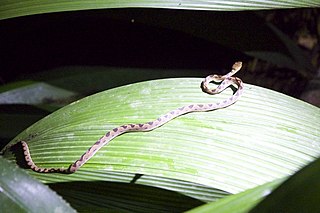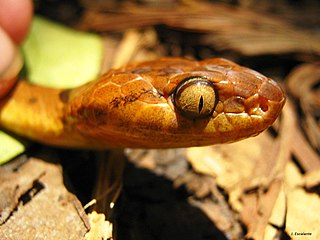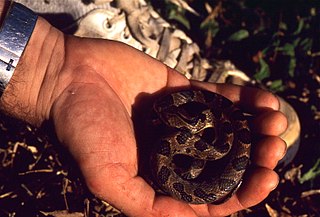
The banded cat-eyed snake is a species of mildly venomous, rear-fanged, colubrid snake, endemic to the New World.

Leptodeira is a genus of colubrid snakes commonly referred to as cat-eyed snakes. The genus consists of 17 species that are native to primarily Mexico and Central America, but range as far north as the Rio Grande Valley region of Texas in United States and as far south as Argentina in South America.

Callimedusa tomopterna, the tiger-striped tree frog, is a species of frog in the subfamily Phyllomedusinae. It is found in northern South America in the Upper Amazon Basin of Bolivia, Peru, Ecuador, and Colombia, Amazonian Brazil, and the Guianas from southeastern Venezuela to French Guiana. It might represent more than one species.

Leptodeira septentrionalis, the northern cat-eyed snake, is a species of medium-sized, slightly venomous snake, found from southern Texas to Costa Rica.
Leptodeira approximans is a species of snake in the family Colubridae. The species is native to Ecuador, Peru, and Colombia.
Leptodeira ashmeadii, the banded cat-eyed snake, is a species of snake in the family Colubridae. The species is native to Colombia, Venezuela, Trinidad and Tobago, and Brazil.
Leptodeira bakeri, the Aruban cat-eyed snake or Baker's cat-eyed snake, is a species of snake in the family Colubridae. The species is native to Venezuela and Aruba.

Leptodeira frenata, the Mayan cat-eyed snake or rainforest cat-eyed snake, is a species of snake in the family Colubridae. The species is native to Mexico, Guatemala, and Belize.

Leptodeira maculata, the southwestern cat-eyed snake, is a species of snake in the family Colubridae. The species is native to Mexico.
Leptodeira misinawui is a species of snake in the family Colubridae. The species is native to Ecuador.
Leptodeira nigrofasciata, the black-banded cat-eyed snake, is a species of snake in the family Colubridae. The species is native to Mexico, Guatemala, Honduras, El Salvador, Nicaragua, and Costa Rica.
Leptodeira ornata, the northern cat-eyed snake, is a species of snake in the family Colubridae. The species is native to Panama, Colombia, and Ecuador.

Leptodeira polysticta, the small-spotted cat-eyed snake, is a species of snake in the family Colubridae. The species is native to Mexico, Guatemala, Belize, El Salvador, Nicaragua, and Costa Rica.
Leptodeira pulchriceps is a species of snake in the family Colubridae. The species is native to Argentina, Bolivia, Brazil, and Paraguay.
Leptodeira punctata, the western cat-eyed snake, is a species of snake in the family Colubridae. The species is native to Mexico.

Leptodeira rhombifera is a species of snake in the family Colubridae. The species is native to Panama, Guatemala, Honduras, El Salvador, Nicaragua, and Costa Rica.
Leptodeira rubricata is a species of snake in the family Colubridae. The species is native to Costa Rica and Panama.
Leptodeira splendida, the splendid cat-eyed snake, is a species of snake in the family Colubridae. The species is native to Mexico.
Leptodeira uribei, Uribe's cat-eyed snake or Uribe's false cat-eyed snake, is a species of snake in the family Colubridae. The species is native to Mexico.







